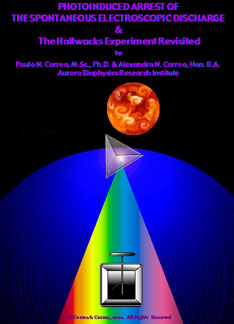![Akronos logo]](/images/akronos_wheel.jpg)
|
Akronos Publishing Concord, ON, Canada www.aetherometry.com |
![Akronos logo]](/images/akronos_wheel.jpg)
|
Akronos Publishing Concord, ON, Canada www.aetherometry.com |

Photoinduced arrest of the spontaneous electroscopic discharge,
and the Hallwacks (Hallwachs) experiment revisited
by Correa, Paulo N. & Correa, Alexandra N.
Published in July 2001. 42 pages.
Experimental Aetherometry, Vol. 2A
Monograph AS2-08
Price: US $25 ($20 ISFA)
This monograph is also included in the print edition of Experimental Aetherometry, Vol. 2A
|
ABSTRACT
We report discovery of a photoinduced regeneration of the (anti)gravitokinetic component of the energy of charges trapped in conductors subject to a local gravitational field. The photoinduced kinetoregeneration of the antigravitational work performed by trapped charge was shown to bring about complete arrest of the spontaneous discharge of the electroscope, in distinction from thermal contributions to the kinetoregenerative phenomenon, which were minor. We also revisit the Hallwachs photoelectric effect observed in charged metallic bodies to determine the real y function of electron emission, and experimentally demonstrate that, unlike what is conventionally assumed, this y function also affects significantly electroscopic seepage rates. From these experimental findings, we make four theoretical suggestions: 1. That the electromagnetic spectrum should be separated in two qualitatively and quantitatively distinct domains: an exclusively discontinuous one, where photons are produced by electron bombardment or the energetic disintegration of matter, and have the property of heterolytically cleaving matter (ionizing it); and a phenomenologically continuous spectrum whose stochastic distribution corresponds to the underlying spectrum of aether wave energy. This first disjunction would distinguish ionizing from nonionizing or optothermal radiation, and we propose that its true boundary lies at a frequency of 6400 THz (and a wavelength of 46.6 nm). This should also constitute the boundary differentiating radiobiology from photobiology, with the former being concerned with the life-inimical effects of ionizing electromagnetic radiation. 2. That the epiphenomenologically continuous portion of the electromagnetic spectrum should also be separated into two qualitatively distinct domains: high frequency optothermal photons (HFOT light), which include far and vacuum UV light and are capable of inducing the homolytic cleavage of matter (free radical reactions), and low frequency optothermal photons (LFOT light), with wavelength longer than 300 nm and including near UV, visible light, IR, radio, microwave and VLF radiations. HFOT light can be shown to be essential for biogenesis, but its effects are in general noxious for cellular systems, whereas LFOT light is in all respects beneficial or essential to cellular life. 3. That the critical distinction between the two types of optothermal light corresponds to the experimental disjunction between the photoelectric effect of HFOT light (the so-called Hallwacks effect) and the (anti)gravitokinetic regenerative effect of LFOT light, (including thermal radiation) which we have experimentally discovered and report on herein. These two distinct and mutually exclusive effects of the two types of optothermal light upon charged metallic bodies reflect the underlying aether interaction, which, to begin with, originates the two quantitatively and qualitatively different types of photon production. 4. Finally, that the true functionalist sense of Reich's proposed disjunction between two hidden qualities of the massfree aether, OR (for ORgone or life-beneficial aether energy) and DOR (for Deadly ORgone or life-inimical aether energy), adequately corresponds to the two components of aether energy responsible for the production of HFOT and LFOT light and their differentiating effects at the electroscope. We do not yet know what is the aether-sourced physical process responsible for the production and disjunction of HFOT and LFOT photons - and this will constitute the object of follow-up communications. |